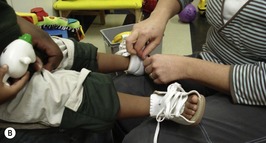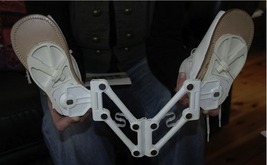Introduction
This is largely an experienced-based clinical chapter. In particular, Table 15.1 outlines my professional opinion and experience with various orthoses for a range of clinical presentations.
| AJ = ankle jerk | |||||||||||||||||||
| F/L = full length | |||||||||||||||||||
| HAV = hallux valgus | |||||||||||||||||||
| met = metatarsal | |||||||||||||||||||
| MTA = metatarsus adductus. | |||||||||||||||||||
| NWB = non-weight-bearing. | |||||||||||||||||||
| SX = symptom | |||||||||||||||||||
| TEV = talipes equinovarus. | |||||||||||||||||||
| Indication | Child’s age | Benefits | Pitfalls | ||||||||||||||||
|---|---|---|---|---|---|---|---|---|---|---|---|---|---|---|---|---|---|---|---|
| Torsional splints | |||||||||||||||||||
| Denis Browne splint | 1. Lower leg torsion/position 2. Post casting: TEV/MTA | 0–5 0–3 (MTA) 0–10 (TEV) | Strong, durable | Heavy | |||||||||||||||
| Ganley splint | 1. Lower leg torsion/ position 2. Post casting: TEV/MTA | 0–3 (MTA) 0–4 (TEV) | Provides positioning of forefoot to rear foot | Time-consuming to fit; unattractive metallic bars/plates | |||||||||||||||
| Counter rotation splint | 1. Lower leg torsion/position 2. Post casting: TEV/MTA | 0–4 0–4 | Hinged bar allows motion, well tolerated | No longer available; easily broken; expensive but best accepted | |||||||||||||||
| Unibar | 1. Lower leg torsion/position 2. Post casting: TEV/MTA | 0–4 0–4 | 360° positioning of foot to bar; lightweight | Not easily available | |||||||||||||||
| Fillauer bar | 1. Lower leg torsion/position 2. Post casting: TEV/MTA | 0–5 0–3 (MTA) 0–10 (TEV) | Clips onto existing footwear | Heavy; clamps often tear sheets | |||||||||||||||
| Wheaton brace | 1. MTA 2. TEV 3. Calcaneovalgus 4. Intoe, out-toe | 0–2 | Does not attach the feet in the manner of bars Can address single foot problems | Not always a sufficiently specific fit; can be hot to wear | |||||||||||||||
| Other splints and devices | |||||||||||||||||||
| NSS | Equinus | 4–15 | Maintains ankle position at rest, yet removable Can adjust ankle position/time | Can be hot to wear. Variable comfort reported | |||||||||||||||
| Cast walker | # e.g. 5th met Ankle inv injury Sever’s | Need to be old enough to manage necessary gait adaptation | Maintains activity and bone stress, yet immobilizes rear foot regions | Must even up limb length with contralateral shoe | |||||||||||||||
| Customized foot wedging, orthoses and splints | |||||||||||||||||||
| Triplane wedges | Non-developmental flat feet, hypotonia, hypermobilty | 1–5 | Cheap, simple, effective | Glued into one pair of shoes | |||||||||||||||
| Gait plates | Intoe with tripping, falling | 3–10 | Cheap simple, often effective | Need a flexible sole shoe | |||||||||||||||
| Thermoplastics, e.g. Aquaplast | Hypermobile flat foot Mild hemiplegia Mild ankle equinus Hallux valgus | 1–6 | Individualized, easy application for hypermobile feet and mild neuromotor tone cases | Takes some practice to perfect fabrication; not durable | |||||||||||||||
| Customized foot orthoses (from foot cast/scan) | Not generally required in children under 10 years | Addresses asymmetry e.g. hemiplegia, size, deformity, trauma. Can use very durable materials | Expensive | ||||||||||||||||
| Prefabricated foot wedging, orthoses | |||||||||||||||||||
| Valgus wedges | Variation on triplane wedges | 1–5 | Cheap, simple, effective | Need to be well positioned to avoid rubbing | |||||||||||||||
| Heel cups | Rear foot instability | 1–3 | Rear foot instability (often hypermobile new or late walkers) when footwear support is beneficial but insufficient | Quickly outgrown (6/12). Require well-secured shoes as movement irritates. Tendency for slippage | |||||||||||||||
| Heel raises | Sever’s and equinus – sport Sx – hemiplegia | 8–14 | Provide quick reduction of calcaneal apophysis traction and resulting symptoms of Sever’s cases | Should only be used to alleviate initial symptoms and for sport. Full-time use contributes to equinus | |||||||||||||||
Prefabricated foot orthoses  (a) rearfoot | Rear foot compensations (NWB rear foot to forefoot congruent) | 5–15 + | Quick, cheap, effective. Can be adapted with extrinsic posting | Sand in shoes reduces durability – advise parents to empty shoes. Leave forefoot space if sock liner is removed (easily filled) | |||||||||||||||
| Prefabricated foot orthoses F/L (b) midfoot | Forefoot compensations (NWB rearfoot to leg basically congruent) | 5–15 + | Quick, cheap, effective. Can be adapted with extrinsic posting. Do not move in shoes which is ‘anti-blistering’ for sports | Do not always transfer well between different shoe styles due to specific full-length trim. Less durable than  -length style (not a big issue when considering foot growth) -length style (not a big issue when considering foot growth) | |||||||||||||||
Footwear selection is often fundamental and intrinsic to the use of foot orthoses and in-shoe wedging and also for the use of torsional splints (Ch. 14).
Footwear and attached splints are also an integral part of the management of metatarsus adductus (Ch. 9) and talipes equinovarus (Ch. 8).
Key Concepts
Key Concepts
The efficacy and benefit of foot orthoses for adults is not in doubt (Landorf & Keenan 2000). Much less is known, however, about the value of foot orthoses for children, in whom there is well-founded concern about unnecessary and expensive use of foot orthoses (Pfeiffer et al 2006; Rome et al 2006; Staheli, 1987 and Staheli, 1999; Wenger et al 1989; Whitford & Esterman 2007).
Classification of children’s flat foot types assists the clinical decision-making process regarding development, monitoring and treatment need or options. Using the paediatric flat foot proforma (p-FFP; Evans 2007) may clarify this sometimes murky and poorly rationalized process for clinicians and parents (see Ch. 6). While less common, excessive supination may also require foot orthoses.
Splints, boots and in-shoe orthoses
Splints (and bars)
By definition, splints are used to hold a structural position with the rationale of moulding or training these structural tissues into the held position.
The saying ‘just as the twig is bent, so is the tree inclined’ (attributed to Alexander Pope) was long held to be true by clinicians and underpinned the prescription of physical limb and foot splinting for decades (Evans 2007; Ganley, 1984 and Ganley, 1987; Kite 1967). The ability of tissues to respond (stress, strain, form and deform) is not in question here; it is a basic physical property. However, the use of externally applied and worn splints to intrinsically alter foot and leg morphology is well disputed and hence the current decline of the use of most orthopaedic splints. An exception to this is the use of the Ilizarov bone pin external fixation devices which apply forces direct to osseous tissues and are used for fractures, bony torsions, bone length deficits (applied with adjusted tractioning) (Herzenberg et al 1994).
Alongside the questioning of splint efficacy, there has also emerged better knowledge and understanding of the normal developmental trends which exist in the paediatric population: for example, in the past orthopaedic clinics have been quite keen to treat children who presented with an intoeing gait and Denis Browne bars were frequently dispensed to correct the presumed deformity of (medial/internal) tibial torsion. We now question this approach on four main grounds:
1. Some 30% of children under 4 years of age intoe (Thackeray, Beeson, 1996a and Thackeray, Beeson, 1996b).
2. Tibial torsion is expected to be neutral at birth (Cusick 1990, Eckhoff & Johnson 1994).
3. Medial genicular (soft tissue) positioning is commonly mistaken for real tibial torsion (Cusick 1990).
4. The normal angle of gait is −8° to +16° (Losel et al 1996).
There are, however, still applications for which splinting is supported. The maintenance splint for babies with clubfoot who are treated with the Ponseti method has been shown to be a critical factor in the success rate of this ‘gold standard’ technique (Cooper & Dietz 1995; Dobbs et al 2004; Haft et al 2007; Herzenberg et al 2002; Gupta et al 2008; Morcuende et al, 2004 and Morcuende et al, 2005; Ponseti et al, 2003 and Ponseti et al, 2006; Thacker et al 2005; see Ch. 8).
Splinting is also widely used in children with muscular hypertonic conditions and cerebral palsy (Allington et al 2002, Galli et al 2001). In these cases the use of splinting is usually aimed at maintaining muscle length, preventing contracture or shortening, and in doing so reducing the intrinsically deforming forces on young bones (Fabry et al 1994, Kumar & MacEwen 1982).
Night stretch splints
The use of rest or stretch splints often worn at night-time can be useful for children with Sever’s disease (calcaneal apophysitis), idiopathic toe walking and Achilles tendon strains and shortening (Alvarez et al 2007, Evans 2001, Hemo et al 2006). These splints address sagittal plane positions and range of motion and can be rigid, adjustable or a sock and strap system (see Fig. 11.4).
These splints capitalize on the connective tissue property of ‘creep’ – its ability to plastically deform under maintained tensile load. The use of a dorsiflexion toe wedge can add further fascial stretch. Some splints have the foot/leg angle adjustable from 20° plantarflexion to 20° dorsiflexion in 10° increments, which allows for increased stretch loading as the range increases.
While the Denis Browne bar has been and remains the mainstay of torsional splints, there have been a number of other popular devices which will be briefly described (Fig. 15.1).
 |
 |
| Figure 15.1 (A) Denis Browne bar (bent for clubfoot maintenance). (B) Fitting a torsion splint with Markell splint boots. |
Ganley splint
Invented by the late Dr James Ganley DPM (who I was privileged to be hosted and mentored by when studying in Pennsylvania). This is a combination torsion splint with the ability to simultaneously adjust forefoot to rear foot and also foot to leg in all three cardinal body planes. It was designed primarily for the maintenance of metatarsus adductus following corrective serial casting. It can also be used for calcaneovalgus foot deformities and concurrent lower limb rotational problems (Ganley, 1984 and Ganley, 1991).
Counter rotation system (CRS)
This innovative and almost attractive splint was produced by the Langer Corporation in New York. As the name suggests, this splint addresses lower limb rotations, e.g. intoe. Made of white plastic, the multiple hinged joints made this the most user-friendly splint as, unlike all other anti-torsion splints, the rigid bar was replaced with a mobile framework, allowing more movement and better compliance (Fig. 15.2).
The CRS was expensive and unfortunately prone to breaking, especially at the footplate mounting junction. This was a pity, as in my experience the CRS was second to none in terms of addressing rotational problems. Children tolerated the CRS very well as a night-time splint. Rarely was sleep disruption an issue and many children loved their ‘moon boots’ (as some called them) and were reluctant to stop wearing them when the treatment was completed. In contrast, the other torsion bars are not well tolerated, although much better if started very young as in the case of babies with clubfoot correction using the Ponseti method.
Fillauer bar
The Fillauer bar is really an adapted Denis Browne bar which clips onto the child’s boots. In theory the child can wear their regular shoes to bed with the splint attached and then it can be removed in the morning. Like the Denis Browne bar, the Fillauer must be bent (approximately 20°) in the frontal plane to protect the feet from forced flattening pronation. The width of the bar should approximate the child’s shoulder span to protect the hips from destabilizing as is risked with a narrow bar. Clearly, the bar width must be adjusted for growth.
< div class='tao-gold-member'>
Only gold members can continue reading. Log In or Register to continue
Stay updated, free articles. Join our Telegram channel

Full access? Get Clinical Tree



